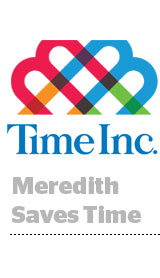
Meredith closed its acquisition of Time Inc. Wednesday to create a media company with 174 million digital US unique visitors – not far behind Google, Yahoo, Facebook, Microsoft and Amazon.
Meredith will triple its digital revenue by acquiring Time Inc., with projected digital revenue this year of $700 million. Digital will contribute 30% to overall ad revenue, the company said.
According to outgoing Meredith CEO Steve Lacy, investors have underestimated the impact that the combined digital scale will have on the company’s business.
“We think digital is the hidden gem inside of this business,” Lacy said.
Combined, Meredith and Time Inc. digital properties will reach 85% of millennial women and 80% of all millennials. It will have the top brand in the lifestyle and food categories. The Meredith leadership team believes that having the number-one or number-two brand in a category gives the publisher an outsize portion of ad revenue.
Plus, the brands will deliver 10 billion video views a year to a digital market clamoring for quality video impressions.
But Meredith will inherit an underperforming Time Inc. that has seen steep declines in its print and digital advertising businesses.
To lead the integration of Time Inc. and turn around its business, president and COO Tom Harty will step in as CEO to lead the integration of Time Inc. with Meredith. Lacy will become executive chairman and focus on strategy as part of this succession plan.
The first order of change: reversing Time Inc.’s sales reorg.
Time Inc. made a strategic mistake 18 months ago when it reorganized its sales team from selling by brands to selling by verticals, Harty said. The move forced Time Inc. salespeople to learn about 22 different magazine brands and led to a lack of support for advertisers around key events like People’s coverage of the Oscars and the Sports Illustrated swimsuit issue.
Time Inc. shot themselves in the foot with the reorganization,” said Susan Bidel, senior analyst at Forrester. “It accelerated their decline in print, and didn’t have a commensurate growth in digital to offset that decline.”
The scaled-up Meredith plans to raise margins in digital and reduce costs overall. Margins in Time Inc.’s digital business will increase to the mid to high teens, putting them in line with Meredith’s digital margins.
The companies also plan to reduce costs by $400 million to $500 million. Brands that aren’t core to the Time Inc. business will be sold off, and Meredith said it’s been impressed with the acquisition prices of media companies in the current market.
The combined Meredith and Time Inc. will also expand use of its data. The company has 225 million addressable email accounts, and it plans to use new segmentation and targeting tools to promote its own titles and help advertisers on both a strategic and tactical level. That includes informing product development, understanding the content customers read and targeting ads.
During the call with investors, Lacy noted that during his tenure Time Inc. was always a market leader, and Meredith wants to elevate its brands after a rocky couple of years.
That struck Bidel, herself a Time Inc. veteran, as a promising sign for Time Inc. employees who will soon integrate with Meredith.
“I think [the Meredith leadership team] was incredibly respectful of how they competed with Time Inc. for 30 years, and Time Inc. was always the market leader,” she said.
This post was syndicated from Ad Exchanger.

More Stories
Meta and X Approve AI Ads Referencing Nazi War Crimes Ahead of German Elections, Research Finds
X Rolls Out AI-Generated Ads in Push to Win Advertisers Back
5 Reasons Nike’s Collab With Kim Kardashian’s Skims Makes Sense